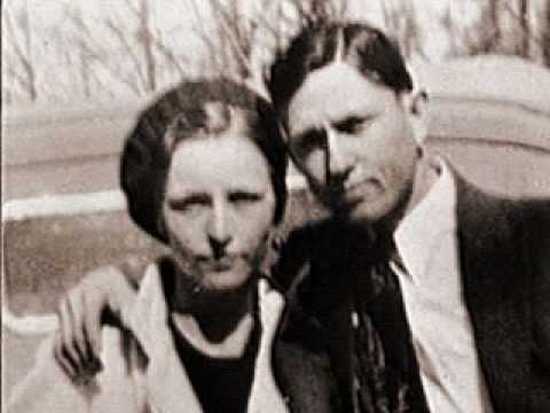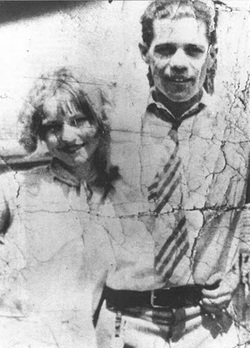Bonnie & Clyde
Forever linked; forever misunderstood
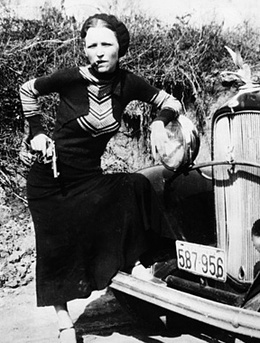
She didn't smoke cigars.
If ever there was a criminal couple tailor-made for — and clearly invented by — the press, it was Texans Clyde Barrow and Bonnie Parker. They have been called everything from a misunderstood modern-day Romeo and Juliet to psychopatic killers who took pleasure in the pain and suffering of others. Now, more 75 years after their deaths, their place in "criminal importance" remains hotly debated by historians.
Even during their lifetimes, the romanticized couple depicted in the press was at considerable odds with the hardscrabble reality of their endless life on the road, particularly in the case of Parker. Even though she was present at more than a hundred crimes and dozens of felonies during her two years with Barrow, she was not the machine gun-wielding cartoon killer portrayed in the newspapers, newsreels and, particularly, the pulp detective magazines of the day.
Gang member William Daniel (W.D.) Jones, who lived into the 1970s, was unsure whether he had ever seen her fire a gun, much less fire one at officers. Blanche Barrow, married to Clyde's brother Buck and who traveled with her husband and the gang for several months, also denied Bonnie's use of weapons. "I was the wild one," Blanche, who lived into the 1980s, once said. "I think Bonnie was afraid of guns. But she surely loved Clyde."
Fact is, Parker’s reputation as a gun-carrying, cigar-smoking gun moll grew out of an abandoned playful snapshot found by police at a gang hideout. The picture — that of Parker holding a gun and puffing on a cigar — was released to the press and immediately capture the nation's attention. It made her and Barrow instant celebrities. Truth is, while she did chain-smoke Camel cigarettes, she never smoked cigars. In fact, months later, as the couple was releasing a kidnap victim and the victim asked them if there was anything they wanted the world to know about them, Parker immediately said, "Yes. Please tell them I don’t smoke cigars."
But her request fell on deaf ears. That photo, as well as others of them hugging, laughing, kissing and displaying an arsenal of high-powered weapons, put the couple on the media map and launched their legend. John Dillinger may have had matinee-idol good looks and "Pretty Boy" Floyd and "Baby Face" Nelson had nicknames tailor-made for newspaper headlines, but it was the candid and unposed photos of Barrow and Parker that introduced the most titillating fact of all — illicit sex. Barrow and Parker were young, unmarried and lived together on the road. To the public, drowning in an economic depression, that meant unbridled sex and that fired a nation’s imagination.
The reality, however, was that Barrow was a small-timer who lived mostly hand-to-mouth by robbing rural gas stations and small country stores, and stealing cars to stay one step ahead of the ever-increasing number of lawmen tracking him. Truth is, without Parker the media outside Texas likely would have dismissed him as one of hundreds of nameless, faceless gun-toting punks - if it ever considered him at all. But with her sexy photographs, Parker supplied the means for a nation to initially overlook the small-scale thefts and needless killings that actually comprised their lives. But perhaps no single moment cemented their place in American folklore more than their bloody deaths on a muggy May Louisiana morning in 1934. They died together in a hail of bullets ... exactly how Parker had predicted.
Even during their lifetimes, the romanticized couple depicted in the press was at considerable odds with the hardscrabble reality of their endless life on the road, particularly in the case of Parker. Even though she was present at more than a hundred crimes and dozens of felonies during her two years with Barrow, she was not the machine gun-wielding cartoon killer portrayed in the newspapers, newsreels and, particularly, the pulp detective magazines of the day.
Gang member William Daniel (W.D.) Jones, who lived into the 1970s, was unsure whether he had ever seen her fire a gun, much less fire one at officers. Blanche Barrow, married to Clyde's brother Buck and who traveled with her husband and the gang for several months, also denied Bonnie's use of weapons. "I was the wild one," Blanche, who lived into the 1980s, once said. "I think Bonnie was afraid of guns. But she surely loved Clyde."
Fact is, Parker’s reputation as a gun-carrying, cigar-smoking gun moll grew out of an abandoned playful snapshot found by police at a gang hideout. The picture — that of Parker holding a gun and puffing on a cigar — was released to the press and immediately capture the nation's attention. It made her and Barrow instant celebrities. Truth is, while she did chain-smoke Camel cigarettes, she never smoked cigars. In fact, months later, as the couple was releasing a kidnap victim and the victim asked them if there was anything they wanted the world to know about them, Parker immediately said, "Yes. Please tell them I don’t smoke cigars."
But her request fell on deaf ears. That photo, as well as others of them hugging, laughing, kissing and displaying an arsenal of high-powered weapons, put the couple on the media map and launched their legend. John Dillinger may have had matinee-idol good looks and "Pretty Boy" Floyd and "Baby Face" Nelson had nicknames tailor-made for newspaper headlines, but it was the candid and unposed photos of Barrow and Parker that introduced the most titillating fact of all — illicit sex. Barrow and Parker were young, unmarried and lived together on the road. To the public, drowning in an economic depression, that meant unbridled sex and that fired a nation’s imagination.
The reality, however, was that Barrow was a small-timer who lived mostly hand-to-mouth by robbing rural gas stations and small country stores, and stealing cars to stay one step ahead of the ever-increasing number of lawmen tracking him. Truth is, without Parker the media outside Texas likely would have dismissed him as one of hundreds of nameless, faceless gun-toting punks - if it ever considered him at all. But with her sexy photographs, Parker supplied the means for a nation to initially overlook the small-scale thefts and needless killings that actually comprised their lives. But perhaps no single moment cemented their place in American folklore more than their bloody deaths on a muggy May Louisiana morning in 1934. They died together in a hail of bullets ... exactly how Parker had predicted.
She longed for excitment
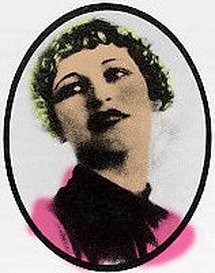
Parker's hgh school photo.
Bonnie Elizabeth Parker was born Oct. 1, 1910, in Rowena, Texas, the second of three children. Her father, Charles Parker, a bricklayer, died when she was four. Her mother, Emma (Krause), moved with the children to her parents’ home in Cement City, an industrial suburb of Dallas, where she found work as a garment sewer. Records indicate Parker was articulate and focused while in high school, winning awards for spelling, writing and public speaking. As an adult, her fondness for writing found expression in poems such as "The Story of Suicide Sal" and "The Trail’s End" (known as "The Story of Bonnie and Clyde.") Both poems would be found with the photographs in the abandoned hideout.
In her second year of high school, according to her mother, she fell in love with classmate Roy Thornton, whose good looks and stylish clothes caught her eye. The pair quit school and married on Sept. 25, 1926, six days before Parker’s 16th birthday.
Things went wrong from the beginning, and the marriage was marked by his frequent absences and brushes with the law until he was finally arrested and sentenced to a lengthy prison term. Although their paths never crossed after January 1929 when he was sent to prison, they never divorced and Parker was still wearing his wedding ring when she died.
Thornton, in prison when he learned of his wife’s death, said, "I’m glad they went out like they did. It’s much better than being caught." He never again spoke publicly about her.
Between the breakdown of her marriage in 1929 and her first meeting with Barrow in January 1930, Parker lived with her mother and worked as a waitress in Dallas. One of her regular customers was a young postal worker named Ted Hinton. In 1932 Hinton would join the Dallas Sheriff’s Department and in 1934, as a posse member, would participate in her death.
She briefly kept a diary in 1929, and she wrote of her desperate loneliness, her impatience with life in provincial Dallas, and her love of a craze that was sweeping the country — small, portable cameras.
In her second year of high school, according to her mother, she fell in love with classmate Roy Thornton, whose good looks and stylish clothes caught her eye. The pair quit school and married on Sept. 25, 1926, six days before Parker’s 16th birthday.
Things went wrong from the beginning, and the marriage was marked by his frequent absences and brushes with the law until he was finally arrested and sentenced to a lengthy prison term. Although their paths never crossed after January 1929 when he was sent to prison, they never divorced and Parker was still wearing his wedding ring when she died.
Thornton, in prison when he learned of his wife’s death, said, "I’m glad they went out like they did. It’s much better than being caught." He never again spoke publicly about her.
Between the breakdown of her marriage in 1929 and her first meeting with Barrow in January 1930, Parker lived with her mother and worked as a waitress in Dallas. One of her regular customers was a young postal worker named Ted Hinton. In 1932 Hinton would join the Dallas Sheriff’s Department and in 1934, as a posse member, would participate in her death.
She briefly kept a diary in 1929, and she wrote of her desperate loneliness, her impatience with life in provincial Dallas, and her love of a craze that was sweeping the country — small, portable cameras.
Schoolboy to Rattlesnake
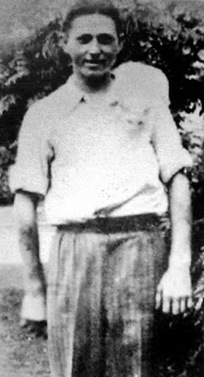
Teenager Clyde Barrow
Clyde Chestnut Barrow was born March 24, 1909, in Ellis County, Texas, near Telico, a town just south of Dallas. He was the fifth of seven children, from a poor farming family that emigrated, piecemeal, to Dallas in the early 1920s as part of a wave of resettlement that moved people from impoverished farms and placed them in the urban slum known as West Dallas. It was a crime-ridden place of flimsy shanties and tent cities, piles of garbage, open sewers, swarming insects and rampaging epidemics.
Barrow's first arrest came in late 1926 when he failed to return a rented car. His second arrest, with older brother Marvin "Buck" Barrow, came soon after; this time for possession of stolen turkeys.
Although Barrow had a series of legitimate jobs from 1927 to 1929, he supplemented his income with criminal activities and there were several arrests for minor offenses during that period. His luck ran out in April 1930, however, when he was sentenced to the Eastham Prison Farm, infamous for its living conditions and brutality.
Barrow, barely 5’7" and 140 pounds, was the target of repeated beatings and sexual assaults by an older, dominant inmate. The attacks ended one rainy fall afternoon when Barrow lured the inmate into the showers with the promise of sex and beat him to death with a length of pipe.
Paroled in February 1932, Barrow emerged a hardened and bitter man. His younger sister Nell, who would one day co-write a book with Parker's mother about the pair's life on the run, remembered a conversation at the time with another sister, Marie, about Clyde. "There’s a new air about him. A funny sort of something I can’t put my finger on," said Nell of that time. "I’m afraid he’s not going to go straight." Years later, Marie was more blunt. "Something awful sure must have happened to him in prison, because he wasn’t the same person when he got out." and, in the 1970s, Ralph Fults, who knew Barrow inside Eastham and would later join Barrow's gang for a short time, said he watched Barrow "change from a friendly schoolboy to a rattlesnake."
In an ironic twist, Barrow, who was unaware he was about to receive early parole, paid another prisoner chop off two of his toes in order to get himself off the grueling chain-gang. Barrow left prison on crutches, and would walk with a limp the rest of his life.
There’s some indication Barrow actually attempted to go straight after his release, even taking a job in Worcester, Mass., for a short time, but with constant police harassment, it wasn’t long before he returned to crime with a vengeance. According to author and Barrow expert John Neal Phillips, Barrow’s goal never seemed to be money, but rather to seek revenge against the Texas prison system for the abuses he suffered while serving time.
Barrow's first arrest came in late 1926 when he failed to return a rented car. His second arrest, with older brother Marvin "Buck" Barrow, came soon after; this time for possession of stolen turkeys.
Although Barrow had a series of legitimate jobs from 1927 to 1929, he supplemented his income with criminal activities and there were several arrests for minor offenses during that period. His luck ran out in April 1930, however, when he was sentenced to the Eastham Prison Farm, infamous for its living conditions and brutality.
Barrow, barely 5’7" and 140 pounds, was the target of repeated beatings and sexual assaults by an older, dominant inmate. The attacks ended one rainy fall afternoon when Barrow lured the inmate into the showers with the promise of sex and beat him to death with a length of pipe.
Paroled in February 1932, Barrow emerged a hardened and bitter man. His younger sister Nell, who would one day co-write a book with Parker's mother about the pair's life on the run, remembered a conversation at the time with another sister, Marie, about Clyde. "There’s a new air about him. A funny sort of something I can’t put my finger on," said Nell of that time. "I’m afraid he’s not going to go straight." Years later, Marie was more blunt. "Something awful sure must have happened to him in prison, because he wasn’t the same person when he got out." and, in the 1970s, Ralph Fults, who knew Barrow inside Eastham and would later join Barrow's gang for a short time, said he watched Barrow "change from a friendly schoolboy to a rattlesnake."
In an ironic twist, Barrow, who was unaware he was about to receive early parole, paid another prisoner chop off two of his toes in order to get himself off the grueling chain-gang. Barrow left prison on crutches, and would walk with a limp the rest of his life.
There’s some indication Barrow actually attempted to go straight after his release, even taking a job in Worcester, Mass., for a short time, but with constant police harassment, it wasn’t long before he returned to crime with a vengeance. According to author and Barrow expert John Neal Phillips, Barrow’s goal never seemed to be money, but rather to seek revenge against the Texas prison system for the abuses he suffered while serving time.
They meet and change history
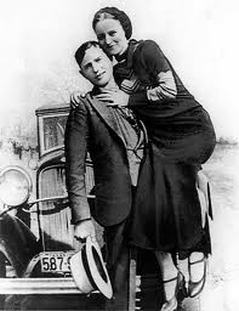
One of the hideout photos.
There are a number of versions describing Barrow and Parker’s first meeting, but the most credible version indicates they met in January 1930 at a mutual friend’s house. Parker was out of work and was staying in West Dallas to assist a girlfriend with a broken arm. Barrow dropped by the girl’s house to visit, and was introduced to Parker.
They took to each other immediately, according to friends, and it wasn't long before they were constant companions. Some say she didn’t know of Barrow’s profession until April when he was arrested and sent to Eastham, but others note her lifestyle — and marriage to a convicted felon — put her in regular contact with wanted men, so it would have been no surprise to her that Barrow was a criminal. No matter, they would remain in contact during the time Barrow was inside.
They took to each other immediately, according to friends, and it wasn't long before they were constant companions. Some say she didn’t know of Barrow’s profession until April when he was arrested and sent to Eastham, but others note her lifestyle — and marriage to a convicted felon — put her in regular contact with wanted men, so it would have been no surprise to her that Barrow was a criminal. No matter, they would remain in contact during the time Barrow was inside.
